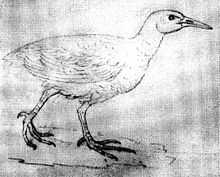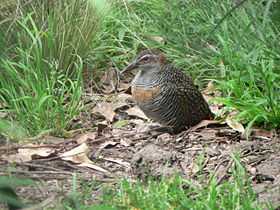Gallirallus
| Gallirallus | |
|---|---|
.jpg) | |
| Weka, Gallirallus australis | |
| Scientific classification | |
| Kingdom: | Animalia |
| Phylum: | Chordata |
| Class: | Aves |
| Order: | Gruiformes |
| Family: | Rallidae |
| Genus: | Gallirallus Lafresnaye, 1841 |
| Species | |
|
11-12 living, several recently extinct, and see text | |
| Synonyms | |
|
Tricholimnas | |
Gallirallus is a genus that contains about a dozen living, and several recently extinct, species of rails that live in the Australasian-Pacific region. The genus is characterised by an ability to colonise relatively small and isolated islands and thereafter to evolve flightless forms, many of which became extinct following Polynesian settlement.
Description
Many of the rails, including the well-known weka of New Zealand, are flightless or nearly so; others, such as the buff-banded rail, can travel for considerable distances once airborne even though they are not great flyers. This has enabled the flying species of this genus to colonize islands all over the region.
Many of the resultant flightless island endemics became extinct after the arrival of humans, which hunted these birds for food, introduced novel predators like rats, dogs or pigs, and upset the local ecosystems. A common Polynesian name of these rails, mainly relatives of G. philippensis, is veka/weka (in English, this name is generally limited to Gallirallus australis).
One species, the Guam rail, is extinct in the wild; there exists a semi-wild population in preparation for reintroduction to its original habitat. Three more species have gone extinct in historic times, while the New Caledonian rail probably is extinct. The Sharpe's rail, only known from the type specimen of unclear origin, may also be extinct, although recent evidence suggests that it is invalid, and instead should be regarded as a morph of the buff-banded rail.[1] Two further species are assumed from circumstantial evidence to have survived into the Modern era but are not known from recent specimens.
On the other hand, Gallirallus species are (with the exception of the weka) notoriously retiring and shy birds with often drab coloration. Given that the Okinawa rail and the Calayan rail have only been discovered in the late 20th century and as late as 2004, respectively, it cannot be ruled out that the New Caledonian and Sharpe's rail may still exist.
Living and recently extinct species

- Weka, Gallirallus australis
- Calayan rail, Gallirallus calayanensis
- Tongatapu rail, Gallirallus hypoleucus - extinct (late 18th - 19th century)
- New Caledonian rail, Gallirallus lafresnayanus - probably extinct (c.1990?)
- Sharpe's rail, Gallirallus sharpei - if valid,[1] possibly extinct (20th century?)
- Slaty-breasted rail, Gallirallus striatus
- Norfolk Island rail, Gallirallus sp. - possibly survived to the early 19th century
These species are placed by Birdlife International and IUCN in separate genus Hypotaenidia
- Okinawa rail, Gallirallus okinawae
- Barred rail, Gallirallus torquatus
- New Britain rail, Gallirallus insignis
- Roviana rail, Gallirallus rovianae
- Guam rail, Gallirallus owstoni - extinct in the wild (late 1980s)
- Lord Howe woodhen, Gallirallus sylvestris
- Buff-banded rail, Gallirallus philippensis
- Dieffenbach's rail, Gallirallus dieffenbachii - extinct (mid-19th century)
- Wake Island rail, Gallirallus wakensis - extinct (1945)
- Tahiti rail, Gallirallus pacificus - extinct (late 18th - 19th century)
and also the genus Nesoclopeus
Species extinct before 1500 AD

- Nuku Hiva rail, Gallirallus epulare[2]
- New Ireland rail, Gallirallus ernstmayri
- Ua Huka rail, Gallirallus gracilitibia[2]
- Niue rail, Gallirallus huiatua [3][4]
- Tinian rail, Gallirallus pendiculentus
- Aguiguan rail, Gallirallus pisonii
- Mangaia rail, Gallirallus ripleyi[5]
- Tahuata rail, Gallirallus roletti[2]
- Tubuai rail, Gallirallus steadmani[6]
- Huahine rail, Gallirallus storrsolsoni
- Rota rail, Gallirallus temptatus
- ‘Eua rail, Gallirallus vekamatolu - possibly survived to the early 19th century[7][8]
- Hiva Oa Rail, ?Gallirallus sp.
References
Notes
- ↑ 1.0 1.1 BirdLife International Globally Threatened Forums, 2008
- ↑ 2.0 2.1 2.2 Kirchman, Jeremy J.; & Steadman, David. (2007). "New species of extinct rails (Aves: Rallidae) from archaeological sites in the Marquesas Islands, French Polynesia.". Pacific Science 61 (1): 145–163. doi:10.1353/psc.2007.0008.(subscription required)
- ↑ "Gallirallus huiatua; holotype". Collections Online. Museum of New Zealand Te Papa Tongarewa. Retrieved 16 July 2010.
- ↑ Steadman, David W.; Worthy, Trevor H.; Anderson, Atholl J.; & Walter, Richard. (2000-06-01). "New species and records of birds from prehistoric sites on Niue, southwest Pacific.". Wilson Bulletin 112 (2): 165–186. doi:10.1676/0043-5643(2000)112[0165:NSAROB]2.0.CO;2.(subscription required)
- ↑ Steadman, D. W. (1986). "Two new species of rails (Aves: Rallidae) from Mangaia, Southern Cook Islands.". Pacific Science 40 (1): 27–43.
- ↑ Worthy, Trevor H.; & Bollt, Robert. (2011-01-01). "Prehistoric birds and bats from the Atiahara site, Tubuai, Austral Islands, East Polynesia.". Pacific Science 65 (1): 69–86. doi:10.2984/65.1.069.(subscription required)
- ↑ A similar bird was found to live on nearby Vava‘u in 1793. Given that G. vekamatolu was flightless, this may just as well represent a related species.
- ↑ Kirchman, J.J.; & Steadman, D. W. (2005). "Rails (Aves: Rallidae: Gallirallus) from prehistoric sites in the Kingdom of Tonga, including description of a new species.". Proceedings of the Biological Society of Washington 118: 465–477. doi:10.2988/0006-324x(2005)118[465:rargfp]2.0.co;2.
Sources
- BirdLife International Globally Threatened Forums (2008). Sharpe’s Rail (Gallirallus sharpei): no longer recognised taxonomically. Accessed 2008-12-15.
- BirdLife International www.birdlife.org
|
